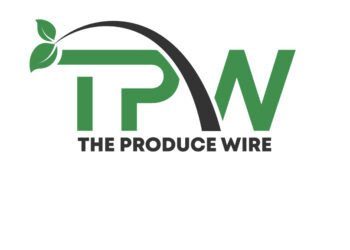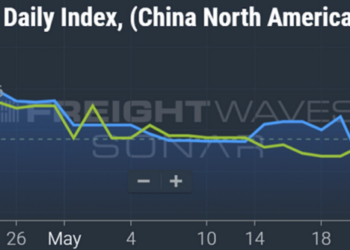Tariffs are making Canadian highway capacity scarcer
An index of outbound Canadian tenders, or shippers’ requests to move loads, is shown in white on the right axis. The percent of those tenders that are rejected by carriers is shown in red, on the left axis. (Chart: SONAR)
A week ago, it wasn’t clear whether the tariffs on Canada and Mexico would actually be implemented. But, as the first business days of March approached and it became clearer that the North American tariffs were all systems go, shippers rushed to move freight from Canada to the U.S. to avoid the tariffs that went into effect Tuesday. That led to an increase in outbound Canadian freight tender volume (white line above), which includes a large portion of cross-border loads, and an even sharper increase in the portion of those tenders that were rejected by carriers due to a lack of capacity and/or the availability of more lucrative spot loads. Specifically, after carriers rejected an average of 4.8% of outbound Canadian tenders in January and 6.6% in February, carriers have rejected 10.1% of outbound Canadian tenders in the past seven days.
US flatbed tender rejection rate spikes
Flatbed carriers are now rejecting 24% of tenders, up from around 10% in mid-February. Presumably, that is related to moving Canadian lumber in a last-ditch effort to avoid tariffs. (Chart: SONAR)
China-to-US ocean spot rates hit 52-week low
Ocean spot rates from China to the U.S. are sinking, down 59% and 45% since the first business day of the year for routes from China to the West and East coasts, respectively. That decline in rates reflects more than just tariffs – shipbuilding is adding capacity and it’s a seasonally weak time. It also appears to reflect demand that has been slow to return following Chinese New Year and also a pull-forward of imports. (Chart: SONAR)
Air cargo rates sink to lowest level since early 2020
Air cargo rates never returned to pre-pandemic levels – but may be headed there now. A permanent reduction in business travel has reduced available belly space in passenger planes. In addition, with help from the de minimis exemption, cheap e-commerce volume exploded and those companies’ made-to-order business models created air cargo demand from categories where none previously existed. Now, the U.S. seeks to do away with the de minimis exemption as soon as it can figure out how to process 1 billion annual low-value shipments without slowing other imports. (Chart: SONAR)
US import bookings still above year-ago levels, for now
Record-setting import volume, particularly at the U.S. West Coast ports, was one of the major freight events of 2024. That strength has continued to start the year, but the question is – for how long? Major industry players, including the National Retail Federation and Western Class I railroad Union Pacific, believe there was a pull-forward of imports to avoid tariffs. That could lead to a sharp falloff later this year. (Chart: SONAR)
Warehouses are getting full and costs are rising
Providing further support for the view that an import pull-forward to avoid tariffs had major impacts on freight markets, the Logistics Managers’ Index showed a dramatic inventory spike, particularly for upstream inventories. The index of inventory levels (white line) and warehousing prices (red line) are 65 and 77, both well above the threshold of 50, which marks expansion. See article here for detail. (Chart: SONAR)
Intermodal volume outperforming truckload volume
Volume in the slower and low-cost options, such at international intermodal (white) and domestic intermodal (red), are outperforming volume in the higher-speed truckload options – dry van truckload (green) and long-haul truckload (yellow) – because a pull-forward of imports has made freight less time-sensitive. All data in the chart above is outbound from Greater Los Angeles. (Chart: SONAR)
For more on SONAR or to request a demo, visit gosonar.com.
The Stockout Show: Why did Walmart buy a shopping mall?
(Image: FWTV)
On Monday’s The Stockout show, Grace Sharkey and I discussed the FreightWaves 3PL Summit, the weakening air cargo market, the domestic freight markets and Walmart’s purchase of a Pittsburgh-area shopping mall.
Walmart’s acquisition of Monroeville Mall, a major shopping center, may or may not mark an evolution in its strategy. It could just be a real estate deal for a property that Walmart considered a good value. After all, it’s less burdensome to put a store on an existing commercial site with infrastructure in place rather than dealing with zoning laws and other regulatory hurdles. The counterpoint is that the deal sounds consistent with a 2018 Walmart announcement in which the retailer described its intention to develop malls in current superstore parking lots, referring to the space as Town Centers. At that time, the company said it wanted to provide pedestrian connectivity from stores to other amenities. From that perspective, it may be part of a broader revenue growth strategy to attract higher-income consumers who reside in urban centers.
Check out Monday’s show and the full The Stockout playlist.
The post Tariffs in 7 SONAR charts appeared first on FreightWaves.














